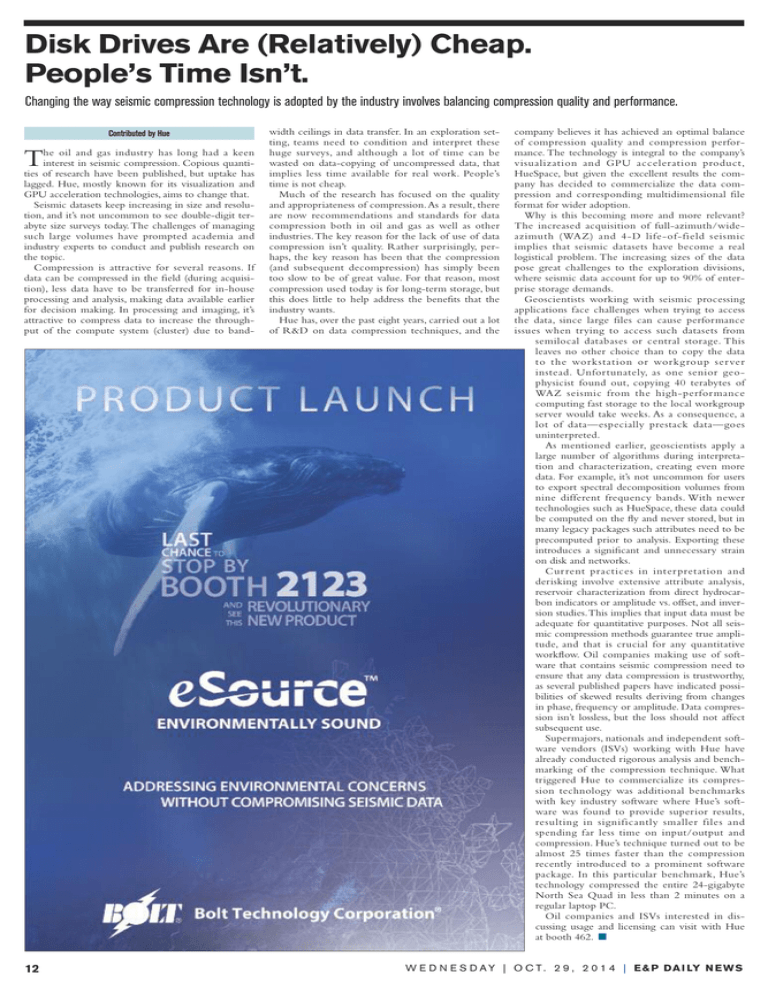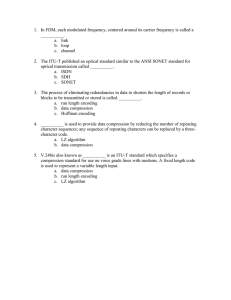Disk Drives Are (Relatively) Cheap. People`s Time Isn`t.
advertisement

Disk Drives Are (Relatively) Cheap. People’s Time Isn’t. Changing the way seismic compression technology is adopted by the industry involves balancing compression quality and performance. Contributed by Hue he oil and gas industry has long had a keen interest in seismic compression. Copious quantities of research have been published, but uptake has lagged. Hue, mostly known for its visualization and GPU acceleration technologies, aims to change that. Seismic datasets keep increasing in size and resolution, and it’s not uncommon to see double-digit terabyte size surveys today. The challenges of managing such large volumes have prompted academia and industry experts to conduct and publish research on the topic. Compression is attractive for several reasons. If data can be compressed in the field (during acquisition), less data have to be transferred for in-house processing and analysis, making data available earlier for decision making. In processing and imaging, it’s attractive to compress data to increase the throughput of the compute system (cluster) due to band- T 12 width ceilings in data transfer. In an exploration setting, teams need to condition and interpret these huge surveys, and although a lot of time can be wasted on data-copying of uncompressed data, that implies less time available for real work. People’s time is not cheap. Much of the research has focused on the quality and appropriateness of compression. As a result, there are now recommendations and standards for data compression both in oil and gas as well as other industries. The key reason for the lack of use of data compression isn’t quality. Rather surprisingly, perhaps, the key reason has been that the compression (and subsequent decompression) has simply been too slow to be of great value. For that reason, most compression used today is for long-term storage, but this does little to help address the benefits that the industry wants. Hue has, over the past eight years, carried out a lot of R&D on data compression techniques, and the company believes it has achieved an optimal balance of compression quality and compression performance. The technology is integral to the company’s visualization and GPU acceleration product, HueSpace, but given the excellent results the company has decided to commercialize the data compression and corresponding multidimensional file format for wider adoption. Why is this becoming more and more relevant? The increased acquisition of full-azimuth/wideazimuth (WAZ) and 4-D life-of-field seismic implies that seismic datasets have become a real logistical problem. The increasing sizes of the data pose great challenges to the exploration divisions, where seismic data account for up to 90% of enterprise storage demands. Geoscientists working with seismic processing applications face challenges when trying to access the data, since large files can cause performance issues when trying to access such datasets from semilocal databases or central storage. This leaves no other choice than to copy the data to the workstation or workg roup ser ver instead. Unfortunately, as one senior geophysicist found out, copying 40 terabytes of WAZ seismic from the high-perfor mance computing fast storage to the local workgroup server would take weeks. As a consequence, a lot of data—especially prestack data—goes uninterpreted. As mentioned earlier, geoscientists apply a large number of algorithms during interpretation and characterization, creating even more data. For example, it’s not uncommon for users to export spectral decomposition volumes from nine different frequency bands. With newer technologies such as HueSpace, these data could be computed on the fly and never stored, but in many legacy packages such attributes need to be precomputed prior to analysis. Exporting these introduces a significant and unnecessary strain on disk and networks. Cur rent practices in inter pretation and derisking involve extensive attribute analysis, reservoir characterization from direct hydrocarbon indicators or amplitude vs. offset, and inversion studies. This implies that input data must be adequate for quantitative purposes. Not all seismic compression methods guarantee true amplitude, and that is crucial for any quantitative workflow. Oil companies making use of software that contains seismic compression need to ensure that any data compression is trustworthy, as several published papers have indicated possibilities of skewed results deriving from changes in phase, frequency or amplitude. Data compression isn’t lossless, but the loss should not affect subsequent use. Supermajors, nationals and independent software vendors (ISVs) working with Hue have already conducted rigorous analysis and benchmarking of the compression technique. What triggered Hue to commercialize its compression technology was additional benchmarks with key industry software where Hue’s software was found to provide superior results, resulting in significantly smaller files and spending far less time on input/output and compression. Hue’s technique turned out to be almost 25 times faster than the compression recently introduced to a prominent software package. In this particular benchmark, Hue’s technology compressed the entire 24-gigabyte North Sea Quad in less than 2 minutes on a regular laptop PC. Oil companies and ISVs interested in discussing usage and licensing can visit with Hue at booth 462. n W E D N E S D A Y | O C T . 2 9 , 2 0 1 4 | E & P DA I LY N E W S



